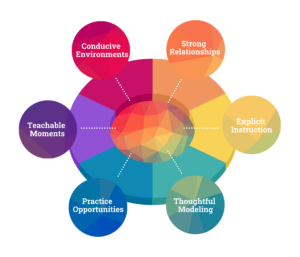Ask anyone who has studied Bloom’s Taxonomy and they’ll tell you that just because students learn something once does not mean they have internalized that learning, can connect it to something else they know, or apply it to new situations. By “learning,” we refer to anything that children learn, like how to tie their shoes, multiply fractions, or recognize and label their emotions.
Because of the COVID-19 pandemic, however, students are no longer seeing their teachers in person, sitting around a table to work through assignments in small groups, or interacting with peers in the hallways. Due to the challenges of an ever-evolving distance learning environment, it can be difficult to provide students with guided practice that ensures continued development of their social-emotional skills and mindsets.
It’s important to continue to carve out time for social-emotional learning even as we move our lessons online, so that students get frequent, varied opportunities to practice and grow their skills. We recommend that teachers continue to create practice opportunities and leverage teachable moments throughout each class using some of the strategies and resources below.
When creating opportunities for students to practice SEL, consider ways to make things enjoyable and stress-free. For instance, you can build in “brain breaks” to encourage healthy activity and emotional regulation. Try using these videos as well as these Breathe, Think, Do, Get Movin’, and Body Scan activities, or simply encourage students and families to PLAY!
It’s also critical to create opportunities for students to reflect on the current situation (in a developmentally appropriate way, of course) and begin to process how school closures and other events in their lives are affecting them socially, physically, and emotionally. You can integrate self and social awareness by incorporating gratitude practices at the elementary and middle/high school levels. Assign journaling to promote self-awareness, self-reflection, processing of emotions, and as a mode of connection. As a trusted adult to whom students turn for guidance, try to discuss current events and the ways in which social emotional skills and topics are showing up in the world. This can be done thoughtfully at any age.
Partnerships between educators and families are increasingly powerful ways to help students develop strong social-emotional skills and mindsets. Educators can incorporate discussion prompts into reading assignments for families to engage in supportive conversations. Another way to reflect together is to encourage discussion about podcasts (see The Imagine Neighborhood), or jointly watch and discuss movies that address social emotional topics.
Social-emotional competencies such as self-regulation, social awareness, and responsible decision making must be taught, modeled, and practiced often in order to be learned. Because the development of social-emotional skills is informed by context, culture, and students’ interactions with different environments, it is important that SEL-related activities focus on helping students to learn, build, and practice skills that they can apply to different settings in school, at home, and in the community. This is the basis for Transforming Education’s SEL Integration Approach. 


